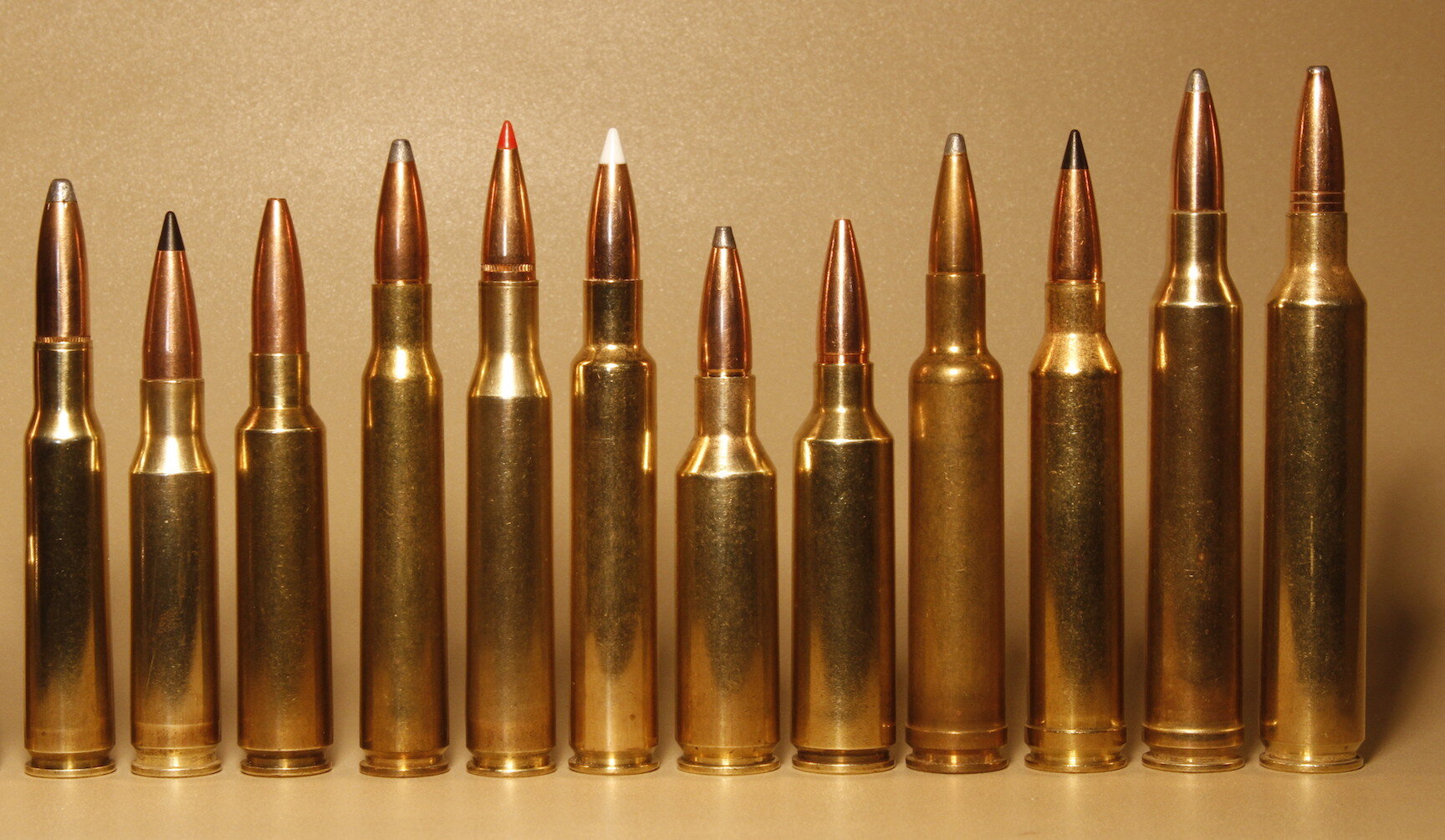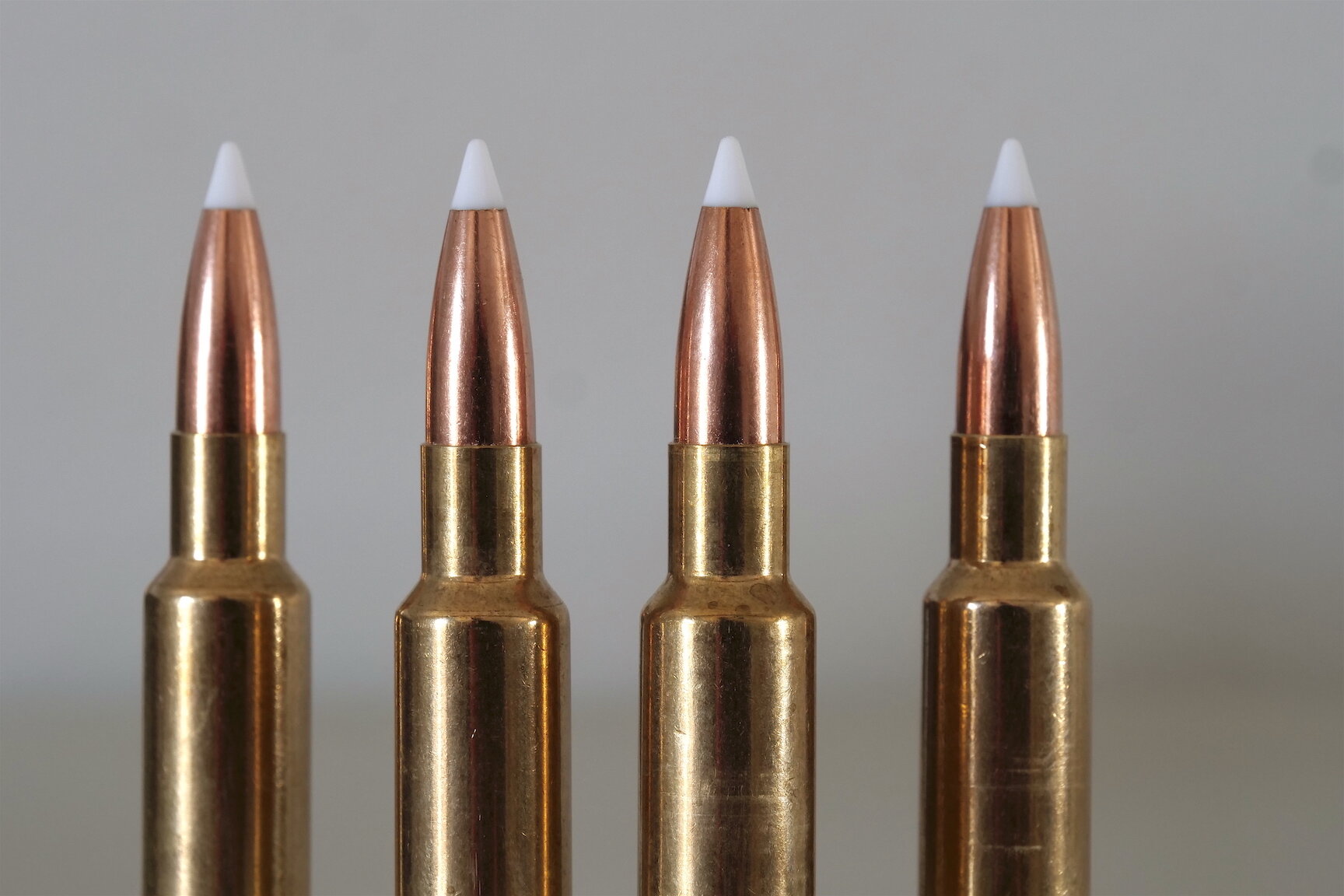280 AI My My My!
As sometimes happens in the world of rifle cartridges, the 280 AI (Ackley Improved) is becoming more popular than its parent, the excellent 280 Remington. Here’s why:
280 AI shoots 50 fps to 100 fps faster than the 280 Remington with the same bullets in the same standard-length actions.
280 Remington chambers can be easily converted to 280 AI.
A 280 AI can safely fire 280 Remington ammunition, simultaneously fire-forming brass cases to reloadable 280 AI dimensions.
280 AI was standardized by Nosler in 2008 and, SAAMI approved, is now being sold as factory loaded ammunition.
More and more production rifles are being chambered for 280 AI every year.
Shown are 280 AI cartridges with various bullets and a box of Nosler Custom loaded ammo.
Exactly What is the 280 AI?
Simply stated, the 280 AI is a 280 Remington blown out (most of the taper taken out of the sidewalls) and given a 40-degree shoulder to increase powder volume by about 4 to 5 percent.
To set the stage for this cartridge description, you should know that it is but one of more than a dozen commercially loaded 7mm cartridges now on the market that fire .284-inch diameter (28-caliber) bullets. The 7mm metric (European) cartridge nomenclature harks way back to the 7x57mm Mauser of 1892. This original 7mm gave rise to the 30-06 and all subsequent cartridges based on it, but it also inspired a lot of other 7mm rounds.
In the U.S. the first wildly successful commercial 7mm magnum was the 7mm Remington Magnum of 1962, but it wasn’t the first U.S. 7mm. Roy Weatherby’s proprietary 7mm Wby. Mag. actually preceded it by 18 years. That seems early until you learn the 280 Ross, quite popular in Canada and leaking down into the U.S., was a 1906 release. It could push 150-grain bullets about 2,800 fps. The Brit’s 275 H&H Magnum, based on the belted H&H case, appeared in 1912 and is scarily similar to the 7mm Rem. Mag., both driving 160-grain bullets to nearly identical speeds. The German 7x64mm Brenneke began taking game in 1917. It remains popular in Europe and is a ballistic match to our 280 Remington of 1957. The belted 7x61mm Sharpe & Hart Super came out in 1953. Like the (copycat?) 7mm Rem. Mag., it was based on a shortened 300 H&H case.
A Redundant Confusion of 7mm/280 Cartridges
Photo depicts a line of 12 7mm cartridges including white tipped 280 AI near center
Despite the above redundant confusion of cartridges shooting .284-inch bullets, that list is not complete. Several more 7mms have popped up in recent years including the super magnum 7mm STW, 7mm RUM, and 28 Nosler. Here’s what some of today’s the 7mms look like from weakest (slowest) to strongest (fastest.) Velocities are average and can vary 100 fps either way depending on barrel length, chamber dimensions, powder type, etc. Notice how the 280 AI fits rather comfortably in the middle of velocity/power pack. This plays a significant role in its rising popularity, as we’ll see.
7x57mm Mauser, 150-grain 2,800 fps
7mm-08 Remington, 150-grain 2,850 fps
284 Winchester, 150-grain 2,850 fps
280 Remington, 150-grain 3,000 fps
7mm SAUM, 150-grain 3,050 fps
280 Ackley Improved, 150-grain 3,100 fps
7mm WSM, 150-grain 3,140 fps
7mm Remington Magnum, 150-grain 3,250 fps
7mm Weatherby Magnum, 150-grain 3,300 fps
7mm STW, 150-grain 3,330 fps
7mm RUM, 150-grain 3,368 fps
28 Nosler, 150-grain 3,400 fps
With So Many Choices, Why the 280 AI?
Image shows Rifles Inc. 280 AI lying on ground with Nosler 280 AI ammo, binocular, Leupold scope.
Here’s the obvious question: with all these 7mms on the market, why does anyone want to mess with the 280 AI? It adds only about 50-fps to 100-fps to 280 Remington speeds, yet falls short of 7mm Rem. Mag. performance by about the same speeds. Isn’t the 280 AI slicing this ballistic pie a bit thin?
Well, maybe not when you consider its ballistic performance plus a few gun-fit, gun-handling, and handloading issues. Drive Nosler's 150-grain AccuBond Long Range bullet 3,050 fps in a 10 mph wind, zero it for maximum-point-blank-range (10-inch target,) and with a dead-center aim your bullets should stay within that target out to 376 yards. Peak trajectory would be 4.96-inches above point-of-aim at 175 yards. Wind deflection at 400 yards would be about 8.5 inches. That bullet should retain 1,500 f-p energy at 600 yards and remain super sonic at 1,600 yards. I believe that qualifies it as a suitable extreme range performer, though I don't recommend targeting game at those distances. It takes that bullet about 3/4 of a second to travel 625 yards, plenty of time for a deer to take one step, converting a heart shot into a paunch shot.
Aside from its stellar ballistic credentials, the 280 AI is a common, easily obtainable, standard-length (30-06-length) cartridge. It's also a 30-06 rim-size. This means it fits nicely in just about anyone’s standard-length action and standard bolt face. This gives shooters a lot of options in rifle brands. Any modern, strong bolt-action that can handle a 30-06, 270 Win., 25-06 Rem. 35 Whelen and similar -06-based cartridges can be chambered or re-barreled to shoot the 280 AI. Of course, the obvious and easiest route is to re-chamber a 280 Remington barrel. Any good gunsmith should be able to handle this. You can shoot factory 280 Remington loads in the 280 AI chamber to fire-form cases.
Shaw Custom Barrels sells new barrels in five different contours chambered, crowned, and threaded for your specified action for as little as $160. In 7mm you can specify 1-8” or 1-9.5” twist rates. Given the rising popularity of long, sleek, aerodynamically efficient bullets, I’d go with the 1-8”.Rebarreling is a great option if you already have a “shot-out” barrel on any standard-length action.
280 AI Rifle Inc. in a backpack on a glacial moraine.
The smaller diameter of the 280 Rem. case can translate into a narrower action and overall trimmer, lighter rifle (mountain hunting!) but this depends on the maker. Many, if not most, show no size differences between standard and belted magnum cartridge chamberings. Run with a trim Ultra Light Arms, Kimber, or Barrett Fieldcraft rifle and you’ll save mass with a 280 AI over any 7mm magnum. Similarly, by shooting a 280 AI instead of 7mm Rem. Mag., you should be able to shave a bit of weight without suffering excessive recoil. Recoil is a product of ejecta mass (powder as well as bullet) and velocity. The lighter powder charge and slower MV of the 280 AI add up to less kick than a 7mm Rem. Mag. flinging the same bullet. How much less? Not a lot, but...
Recoil Levels in 7-pound Rifles
280 AI, 150-grain bullet, 3,100 fps: 26.86 f-p recoil energy, 15.7 fps recoil velocity.
7mm Rem. Mag., 150-grain bullet, 3,248 fps: 29.16 f-p recoil energy, 16.37 fps recoil velocity.
280 AI Handy for Handloading
Handloaders love the 280 AI for the same reason they love most Ackley Improved cartridges: the slight increase in speed plus the decreased need to trim-to-length when reloading. Or so it is claimed. Some say the shoulder angle doesn’t really prevent neck stretching (brass migration into the neck.) Others insist it does. I've not conducted any scientific tests, but I’ve certainly had to do less trimming of my Ackley cartridges than their factory counterparts.
Handloading the 280 AI is straightforward and easy with a wide variety of medium- to slow-burning powders, but this isn’t a handloading-only cartridge these days. You should be able to find the following factory loads:
Nosler Trophy Grade 140-gr AccuBond 3,150 fps
Nosler 140-gr. Ballistic Tip 3,150 fps
Nosler 150-gr. AccuBond Long Range 2,930 fps
Nosler 140-gr. E-Tip 3,050 fps
Nosler 160-gr. Partition 2,950 fps
Hornady Precision Hunter 162-gr. ELD-X 2,850 fps
Copper Creek Cartridge Co. 168-gr. Berger VLD Hunting 2,950 fps
CCCC 162-gr. Hornady ELD-X 2,970 fps
CCCC 140-gr. Berger VLD Hunting 3,100 fps
CCCC 145-gr. Barnes LRX 3,070 fps
CCCC 150-gr. Hornady ELD-X 3,050 fps
CCCC 140-gr. Nosler AccuBond 3,140 fps
CCCC 160-gr. Nosler AccuBond 2,940 fps
Any 280 AI Negatives?
Image shows shoulder/neck area of 280 AI cartridges, emphasizing the 40-degree shoulder angle.
Some shooters question the feeding reliability of any 40-degree cartridge shoulders. The rather quick transition from straight cartridge wall to blunt shoulder does suggest potential hang ups on some rifle feed ramps, but I sure haven't experienced this on my Rifles, Inc., which is based on a Remington 700 long action. The rifle is so accurate and the round so effective that I have rarely needed more than one shot per animal. I'm going to work with a Kimber Subalpine in 280 AI this spring and will pay careful attention to any feeding issues with it, but I'm truly not concerned.
They Chamber Rifles in 280 AI, Don’t They?
Image shows a scopes, block stocked Rifles Ind. Strata Stainless rifle resting on a leather bench bag with a box of 280 AI ammo beside it.
My first 280 AI was a 5-pound Rifles, Inc. Strata Stainless built by Lex Webernick. The first 3-shots I fired through it (150-grain Barnes X pushed to 3,040 fps by 58 grains of Reloader 19 if memory serves, but don’t trust this data and always work up your own loads carefully) nestled a 5/16th-inch circle. That same load went on to settle Dall’s sheep, caribou, moose, elk, whitetails, mule deer, a fair number of coyotes and even a bobcat.
Rifles, Inc. is still making great, lightweight hunting rifles, but you can now find factory rifles in 280 AI from Kimber, Nosler, Christiansen Arms, Savage, Cooper Firearms, Montana Rifle, and Fierce. There may be others. The 280 AI is quietly but steadily gaining converts.
Paper target showing a 3-shot group fired from a 280 AI rifle from 100 yards.
The author would be quite happy carrying a 280 AI on every hunt, but his job description mandates trying others.





















